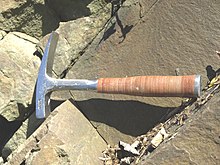Geologist's hammer
The geologist's hammer is a special hammer for geological field work. It is used to strike the rock to create fresh fracture surfaces or to obtain handpieces , since surfaces that have already been weathered often do not allow the original color, the rough mineral composition or the texture of the rock to be determined correctly. The rock samples obtained can be used for further geological investigations, such as an exact rock determination using thin sections , or laboratory methods, such as. B. an isotopic analysis or radiometric dating be used. When looking for fossils , strong blows with the geologist's hammer are used to check a hard block of rock for its fossil content, as this preferably cracks open at the contact surfaces between fossil and adjacent rock. In addition, a geologist's hammer is often used as a yardstick when taking photos in the field.
Basic types
Geologist hammers come in different designs and sizes. A distinction is made between pick hammers and scraper hammers .
- Pick hammers are a combination of hammer and pick . The powerful, slightly downwardly bent hammer spike allows a precise hit with maximum power transmission to a very specific point. Pick hammers are therefore just as suitable for splitting thinly layered or slate rocks as they are for roughly picking out individual mineral layers or fossils from the surrounding rock. The pick hammer also has a greater penetration depth into weathered or loosened rock than a scraper hammer.
- Scraper hammers have a head with a flat fin that is perpendicular to the handle . Similar to a mason's hammer or stonemason's dexel , the fin has a sharpened cutting edge, but is usually narrower. It is primarily used to cut the rock samples into manageable pieces, but also to clean an outcrop of vegetation or loose rock with a small hoe . Contrary to expectations, scrapers are only suitable to a limited extent for splitting handpieces along their layering , because for this the cutting edge has to hit exactly parallel to the layer, which is not always possible.
The power of a hammer depends largely on the weight of the head and the length of the handle. The heavier and longer, the more effective the blow, but also the more unwieldy the hammer. Hammers with a weight of 350 to 650 g and a handle length of 30 to 40 cm are common. A hammer weighing around 460 g is considered useful for most purposes. In softer sedimentary rocks , lighter (scraping) hammers are often completely sufficient. Heavier (pick) hammers are often used for hard metamorphic and igneous rocks.
Special forms
Much smaller precision hammers, weighing 225 g and less, are used in archeology . In mountainous regions with very hard crystalline stones, very heavy and long pick hammers are sometimes used, with a weight well over 700 g and a handle up to 80 cm in length. The hammer can be used like a walking stick , with the head as a handle, or similar to an ice ax .
Geologist's hammers are popular because the shaft and head are forged from a single piece of hardened steel . In contrast to hammers with a handle made of wood or a welded steel tube, the weight distribution is more even with a solid steel hammer and the overweight of the head creates less imbalance when striking (which is particularly gentle on the wrist). In addition, the risk of the head breaking off when overused is much lower. However, hammers with an attached handle are significantly (up to halfway) cheaper, and a wooden handle has the advantage that it can be easily replaced, while a broken steel hammer becomes unusable. The handles of steel hammers are usually made of vinyl . Leather handles , while more decorative, are less slip-resistant and tend to dry out and come off.
Occupational safety
Special care is required when working with the geologist's hammer (e.g. protective goggles , gloves), as fragments of stone or steel can act like projectiles. It is particularly dangerous to use two geologist's hammers, similar to a mallet and iron , as steel splinters can be expected to flake off when the toughness and hardness are identical. It is also not recommended to use geologist's hammers, such as a so-called jet stick, to forcibly break cracks in the rock. The metal bends easily and becomes brittle or the handle breaks off.
Trivia
In the film The Condemned , a geologist's hammer plays an important role. The protagonist gets to know his best friend in prison while getting the hammer, and in 20 years he will use it to dig his way to freedom.
Web links
- Thomas B .: About the "right" tool! (The right hammer) , Steinkern.de, September 20, 2005 Evaluation of various geologist's hammers, especially for fossil hunters.



